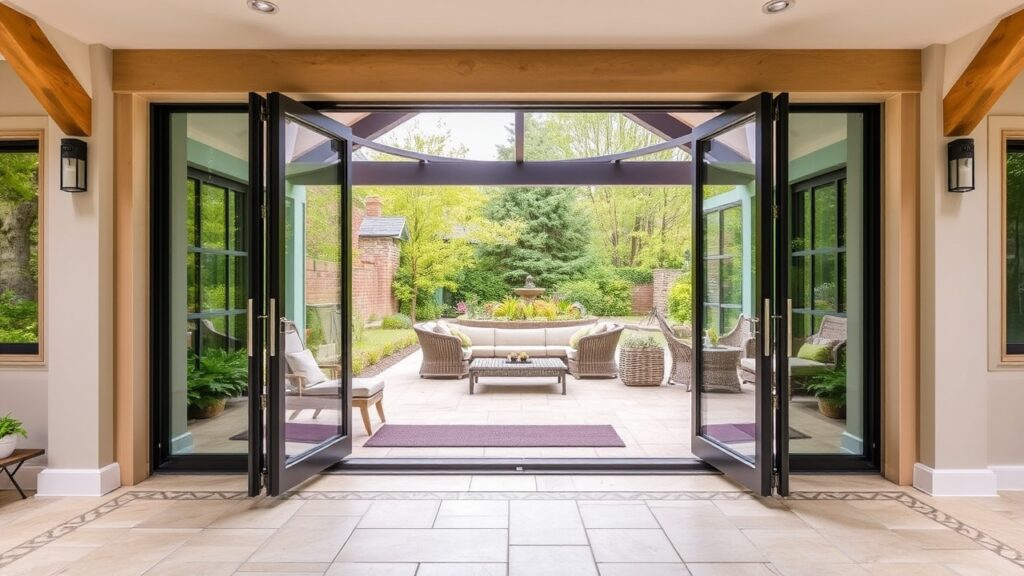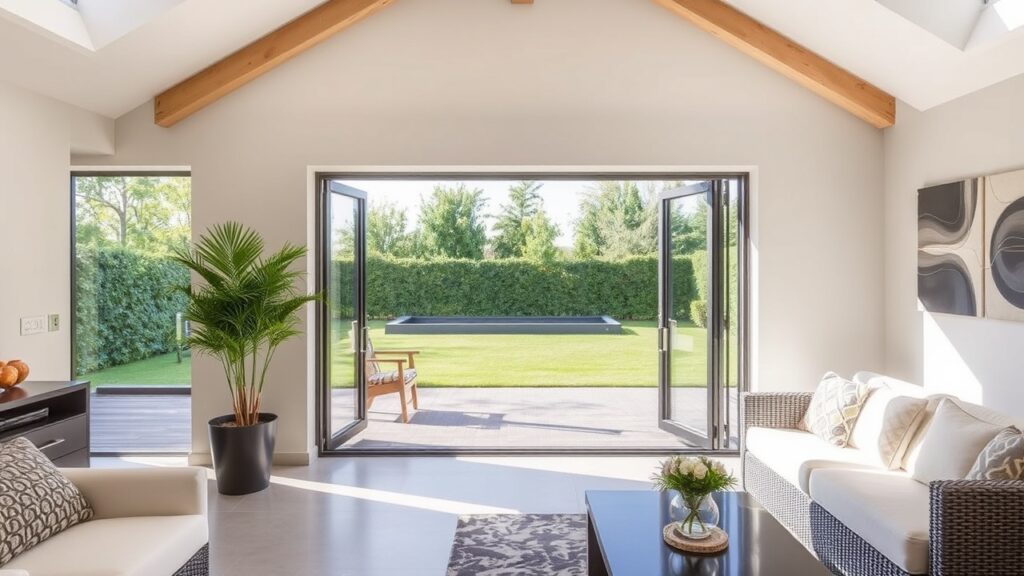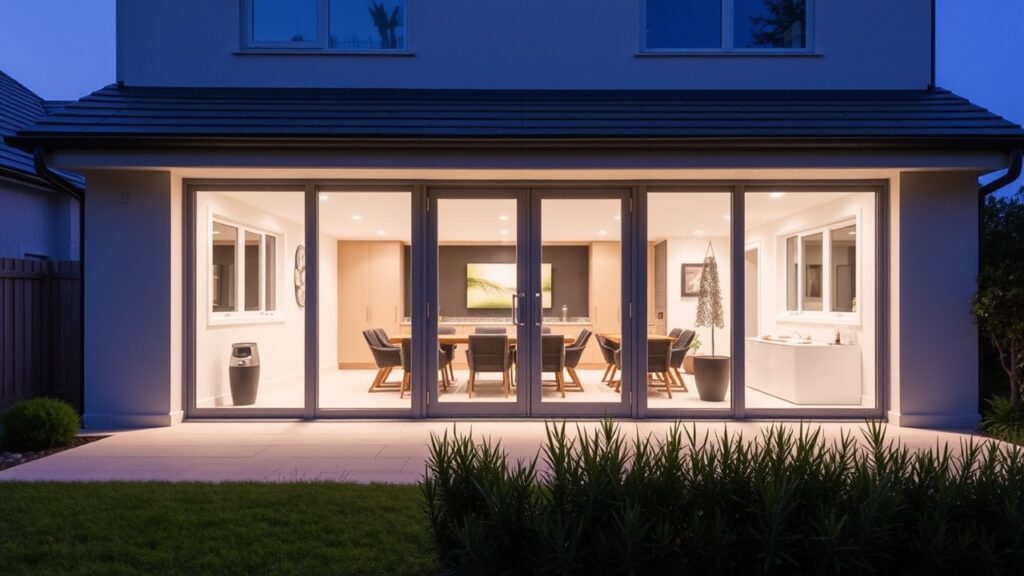Patio doors play a crucial role in a home’s overall energy efficiency. These doors serve as a gateway between the indoor and outdoor spaces, and their performance can significantly impact a home’s heating and cooling costs, as well as its environmental impact. Poorly insulated or improperly installed patio doors can lead to significant energy loss, resulting in higher utility bills and an increased carbon footprint.
When prioritizing energy efficiency, homeowners frequently concentrate on upgrading windows, insulation, and other building components, but they often overlook patio doors. However, investing in energy-efficient patio doors can be a highly effective way to improve a home’s energy performance and reduce its environmental impact. By selecting the right patio door materials, incorporating features like double-glazing, and ensuring proper installation, homeowners can enjoy the benefits of improved comfort, lower energy bills, and a more sustainable living environment.
Patio doors are a significant component of a home’s thermal envelope, and their energy efficiency can have a substantial impact on the overall energy consumption of the household. Homeowners who prioritize energy-efficient patio doors are not only making a smart investment in their home’s value, but they are also contributing to a more sustainable future by reducing their carbon footprint and minimizing their reliance on non-renewable energy sources.
Key Takeaways
- Energy-efficient patio doors can help homeowners save on energy costs and improve comfort in their homes.
- Understanding thermal performance ratings is crucial for selecting the most energy-efficient patio doors.
- Choosing the right patio door material, such as fibreglass or vinyl, can impact energy efficiency.
- Double-glazed patio doors offer increased insulation and energy efficiency benefits.
- Proper installation, maintenance, and addressing air leaks are essential for maximizing the energy efficiency of patio doors.
Understanding Thermal Performance Ratings

When it comes to selecting energy-efficient patio doors, understanding thermal performance ratings is crucial. These ratings provide homeowners with valuable information about the door’s ability to resist heat transfer, which is a key factor in determining its energy efficiency.
The most commonly used thermal performance ratings are the U-value and the Solar Heat Gain Coefficient (SHGC). The U-value measures the rate at which heat is transferred through the door, with a lower value indicating better insulation and higher energy efficiency. The SHGC, on the other hand, measures the amount of solar heat that the door allows to pass through, with a lower value indicating less heat gain and improved energy efficiency.
Understanding these ratings allows homeowners to make informed decisions when selecting patio doors for their homes. They can compare the thermal performance of different door options and choose the one that best fits their climate, energy efficiency goals, and overall home design. This knowledge empowers homeowners to make smart investments in their home’s energy efficiency, leading to long-term cost savings and a reduced environmental impact.
Thermal performance ratings are not just a theoretical concept; they have a tangible impact on a home’s energy consumption and comfort. By selecting patio doors with optimal U-values and SHGC, homeowners can benefit from improved insulation, reduced heat transfer, and better control over their indoor temperature. This, in turn, can lead to lower heating and cooling costs, as well as a more comfortable living environment throughout the year.
Choosing the Right Patio Door Material

When it comes to energy-efficient patio doors, the choice of material is a crucial factor to consider. Homeowners have several options, including wood, vinyl, and aluminium, each with its own unique set of advantages and disadvantages in terms of energy efficiency, durability, and maintenance requirements.
Although people often prize wood patio doors for their natural beauty and classic aesthetic, improper insulation can make them less energy-efficient than other materials. Vinyl patio doors, on the other hand, are known for their excellent insulation properties and low maintenance requirements, making them a popular choice for energy-conscious homeowners. Aluminium patio doors, while durable and low-maintenance, can be less energy-efficient due to their inherent thermal conductivity.
When evaluating patio door materials, homeowners should consider not only the initial cost but also the long-term energy savings and maintenance requirements. A slightly higher upfront investment in a more energy-efficient patio door material can pay dividends over time through reduced utility bills and a smaller carbon footprint.
Ultimately, the choice of patio door material should be based on a careful assessment of the home’s climate, energy efficiency goals, and personal preferences. By weighing the pros and cons of each material, homeowners can make an informed decision that aligns with their needs and supports their commitment to energy efficiency.
The Benefits of Double Glazed Patio Doors
One of the most effective ways to improve the energy efficiency of patio doors is to opt for double-glazed options. Double-glazed patio doors feature two panes of glass separated by a layer of air or inert gas, creating an insulating barrier that helps reduce heat transfer and improve thermal performance.
The primary advantage of double-glazed patio doors is their enhanced insulation properties. The air- or gas-filled space between the two glass panes acts as an effective barrier, preventing heat from escaping the home during the winter and limiting heat gain during the summer. This improved insulation can lead to significant energy savings, as homeowners will need less energy to maintain a comfortable indoor temperature throughout the year.
In addition to improved insulation, double-glazed patio doors also offer enhanced sound insulation, providing a quieter living environment by reducing the transmission of outdoor noise. This feature can be particularly beneficial for homeowners living in areas with high levels of ambient noise, such as near busy roads or airports.
Furthermore, double-glazed patio doors can contribute to improved home security by making it more difficult for intruders to gain access. The additional layer of glass and the air- or gas-filled space between the panes can make it harder to break through the door, providing an extra layer of protection for the homeowner.
Homeowners who invest in double-glazed patio doors can enjoy a more comfortable, energy-efficient, and secure living environment, all while reducing their environmental impact and long-term energy costs.
Proper Patio Door Installation for Maximum Efficiency
| Aspect | Information |
|---|---|
| Material | Wood, vinyl, fibreglass, aluminium |
| Energy Efficiency Rating | Look for ENERGY STAR certification |
| U-Factor | Lower U-factor indicates better insulation. |
| Solar Heat Gain Coefficient (SHGC) | Lower SHGC means less heat gain. |
| Visible Transmittance (VT) | Higher VT means more natural light. |
| Air Leakage | Lower air leakage indicates better sealing. |
| Cost | Varies based on materials and features |
Proper installation is a critical factor in ensuring the energy efficiency of patio doors. If not installed correctly, even the most energy-efficient patio door may not perform as expected, resulting in air leaks, drafts, and significant energy loss.
The importance of professional installation cannot be overstated. Experienced installers understand the nuances of patio door installation and can ensure that the door is properly sealed, levelled, and integrated into the home’s existing structure. They are also familiar with the latest installation techniques and best practices, which can help prevent common issues such as air infiltration and thermal bridging.
During the installation process, particular attention should be paid to the door’s weatherstripping and sealants. These components play a crucial role in creating an airtight seal, preventing air leaks, and maintaining the door’s thermal performance. Improper installation or the use of substandard materials can compromise the door’s energy efficiency, leading to higher energy bills and a less comfortable living environment.
In addition to the initial installation, homeowners should also be aware of the importance of ongoing maintenance and adjustments. Over time, weatherstripping can wear down, and the door’s alignment may shift, compromising its energy efficiency. Regular inspections and timely repairs can help ensure that the patio door continues to perform at its best, delivering long-term energy savings and comfort.
By prioritizing professional installation and maintaining their patio doors, homeowners can maximize the energy efficiency of these crucial home components, contributing to a more sustainable and cost-effective living environment.
Maintaining Energy-Efficient Patio Doors

Maintaining energy-efficient patio doors is essential to ensuring their long-term performance and preserving the benefits of the initial investment. Regular maintenance not only helps to extend the lifespan of the doors but also ensures that they continue to function at their optimal energy efficiency levels.
One of the key aspects of patio door maintenance is the replacement of weatherstripping. Over time, the weatherstripping around the door’s perimeter can become worn, cracked, or dislodged, compromising the airtight seal and allowing air leaks to occur. Homeowners should regularly inspect the weatherstripping and replace it as needed to maintain the door’s thermal performance and prevent energy losses.
In addition to weatherstripping, homeowners should also focus on cleaning and lubricating the door’s moving parts, such as the hinges and rollers. This helps to ensure smooth operation and prevents the door from becoming stuck or difficult to open and close, which can lead to air leaks and energy inefficiencies.
Proper maintenance also involves addressing any issues that may arise, such as warping, cracking, or damage to the door’s frame or glass. Addressing these problems promptly can help to prevent further deterioration and maintain the door’s energy efficiency.
By investing in regular maintenance, homeowners can ensure that their energy-efficient patio doors continue to perform at their best, delivering long-term energy savings and a more comfortable living environment. This commitment to maintenance not only protects the initial investment but also contributes to a more sustainable and environmentally friendly home.
Addressing Air Leaks and Drafts
One of the primary challenges in maintaining the energy efficiency of patio doors is addressing air leaks and drafts. These issues can arise from a variety of sources, including poor installation, worn weatherstripping, and gaps in the door’s frame or surrounding structure.
Air leaks and drafts can have a significant impact on a home’s energy efficiency, as they allow conditioned air to escape and unconditioned air to enter, leading to increased heating and cooling costs. Homeowners may notice drafts around the door’s perimeter or feel cold air seeping in, which can contribute to an uncomfortable living environment.
To address these issues, homeowners can employ a range of solutions, such as weatherstripping replacement, caulking, and door adjustments. Weatherstripping is a crucial component in creating an airtight seal around the door, and replacing worn or damaged weatherstripping can be an effective way to reduce air leaks.
Caulking can also be used to seal any gaps or cracks around the door’s frame, preventing air infiltration and improving the overall energy efficiency of the patio door. Homeowners should be careful to use high-quality, durable caulking materials that can withstand the elements and maintain their seal over time.
In some cases, adjusting the door’s alignment or tightening the hardware may be necessary to address air leaks and drafts. This can involve adjusting the hinges, rollers, or other components to ensure a proper fit and seal.
By addressing air leaks and drafts around their patio doors, homeowners can improve the overall energy efficiency of their homes, reduce their energy costs, and create a more comfortable living environment. This proactive approach to maintenance and problem-solving can contribute to a more sustainable and environmentally friendly household.
Incorporating Patio Doors into an Energy-Efficient Home Design
When designing an energy-efficient home, the placement and orientation of patio doors play a crucial role in maximizing the overall energy performance of the building. Homeowners and architects must carefully consider the impact of patio doors on the home’s thermal envelope, solar gain, and natural ventilation to achieve optimal energy efficiency.
The orientation of patio doors can significantly influence the amount of solar heat gain that enters the home. Strategically positioning the doors to take advantage of passive solar heating during the winter months can reduce the need for artificial heating, while shading or orienting the doors to minimize heat gain during the summer can lower cooling requirements.
In addition to solar gain, the placement of patio doors can also impact the home’s natural ventilation. By positioning the doors in a way that promotes cross-ventilation, homeowners can take advantage of natural air movement to cool the home, reducing the reliance on energy-intensive air conditioning systems.
Integrating patio doors into an energy-efficient home design also involves considering the door’s thermal performance ratings, such as U-value and SHGS. electing doors with optimal thermal properties can help to minimize heat transfer, improve insulation, and contribute to the overall energy efficiency of the home.
Furthermore, the design of the patio door itself can play a role in the home’s energy efficiency. Features like double-glazing, low-emissivity coatings, and thermal breaks can enhance the door’s insulation properties and reduce energy losses.
By carefully considering the placement, orientation, and design of patio doors within the context of an energy-efficient home, homeowners and architects can create a living environment that is not only comfortable and aesthetically pleasing but also highly energy-efficient and environmentally sustainable.
Patio Door Upgrades and Retrofits for Improved Efficiency
For homeowners with existing patio doors that do not meet their energy efficiency goals, there are various upgrade and retrofit options available to improve the performance of these crucial home components.
One of the most straightforward upgrades is to replace the existing patio doors with newer, more energy-efficient models. This can involve switching from single-glazed to double-glazed doors or from less insulative materials like aluminium to more energy-efficient options like vinyl or wood. These upgrades can significantly improve the door’s thermal performance, leading to reduced energy consumption and lower utility bills.
In addition to full door replacements, homeowners can also consider retrofitting their existing patio doors to enhance their energy efficiency. This can include measures such as adding weatherstripping, upgrading the glass to low-emissivity coatings, or installing insulating film on the glass panels. These retrofits can be a more cost-effective solution for homeowners who wish to improve the energy efficiency of their patio doors without the need for a complete replacement.
The potential cost savings and environmental benefits of patio door upgrades and retrofits can be substantial. By investing in these improvements, homeowners can enjoy long-term energy savings, reduced carbon footprints, and increased home comfort. Additionally, these upgrades can enhance the overall value of the property, making it a wise investment for homeowners.
When considering patio door upgrades or retrofits, it is essential for homeowners to work with experienced professionals who can assess the existing door’s performance, recommend the most appropriate solutions, and ensure proper installation. This collaborative approach can help maximize the energy efficiency benefits and ensure that the homeowner’s investment delivers the desired results.
FAQs
What are patio doors?
Patio doors are large glass doors that provide access to a patio or outdoor space from the interior of a home. They are often used to bring natural light into a room and create a seamless transition between indoor and outdoor living spaces.
Why is energy efficiency important in patio doors?
Energy-efficient patio doors can help homeowners save on heating and cooling costs by minimizing heat transfer between the interior and exterior of the home. They can also contribute to a more comfortable indoor environment by reducing drafts and temperature fluctuations.
What factors contribute to the energy efficiency of patio doors?
The energy efficiency of patio doors is influenced by factors such as the type of glass used, the quality of the door frame and seals, and the design of the door itself. Low-emissivity (low-E) glass, multi-pane glazing, and insulated frames are all features that can improve energy efficiency.
How can homeowners improve the energy efficiency of their patio doors?
Homeowners can improve the energy efficiency of their patio doors by choosing doors with high-quality insulation, low-E glass, and airtight seals. They can also consider installing storm doors or using window treatments to further reduce heat transfer.
Are there any energy efficiency ratings or certifications for patio doors?
Yes, there are energy efficiency ratings and certifications for patio doors, such as the ENERGY STAR label. This label indicates that the door meets specific energy performance criteria set by the Environmental Protection Agency (EPA) and can help homeowners identify products that are more energy efficient.


